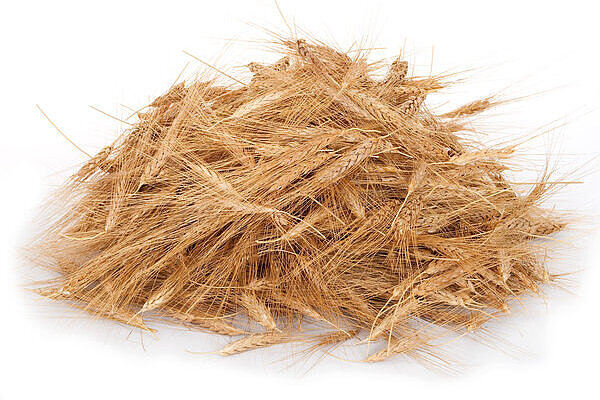Wheat germ flakes

Wheat germ flakes are a popular dietary supplement for humans, but are they also suitable for dogs? In this article you will find out what wheat germ flakes are, what advantages and disadvantages they can have for your dog and how to dose them correctly.
What are wheat germ flakes?
Wheat germ flakes are the dried and crushed germ of the wheat grain. They contain many valuable nutrients, such as
- Vitamin E: a powerful antioxidant that protects cells from free radicals and strengthens the immune system
- B vitamins: important for metabolism, nerve function and blood formation
- Minerals: such as iron, zinc, magnesium and selenium, which are involved in many bodily functions
- Dietary fiber: promotes digestion and makes you feel fuller for longer
- Vegetable proteins : provide essential amino acids for muscle building and regeneration
- Vegetablefats : provide unsaturated fatty acids that have an anti-inflammatory effect and support the cardiovascular system
Wheat germ flakes have a nutty taste and a crunchy consistency. They can be eaten on their own or mixed with other foods.
What are the benefits of wheat germ flakes for dogs?
Wheat germ flakes can also be a useful addition to a dog's diet, especially if they suffer from certain deficiencies or ailments. For example, wheat germ flakes can help
- keep the coat shiny and healthy
- protect the skin from dryness and itching
- accelerate the healing of wounds
- improve fertility
- strengthen the muscles
- calm the nerves
- increase the body's defenses
Wheat germ flakes can also serve as a natural appetite stimulant if your dog eats poorly or is fussy.
What are the disadvantages of wheat germ flakes for dogs?
Although wheat germ flakes are healthy, they are not suitable for every dog. There are a few factors you should consider before giving your dog wheat germ flakes. For example, wheat germ flakes can
- Trigger allergies: some dogs are sensitive to wheat or other grains and show symptoms such as skin rash, itching, diarrhea or vomiting. If your dog has a known grain allergy, you should not give him wheat germ flakes.
- Promote obesity: Wheat germ flakes are very high in calories and should therefore only be fed in moderation. If your dog tends to be overweight or is on a diet, you should reduce or eliminate the amount of wheat germ flakes.
- Influence blood sugar levels: Wheat germ flakes contain carbohydrates, which can raise blood sugar levels. If your dog has diabetes or is at risk, you should not give him wheat germ flakes or only after consulting your vet.
- Cause digestive problems: Wheat germ flakes are very high in fiber and can cause bloating, constipation or diarrhea in some dogs. If your dog has a sensitive gastrointestinal tract or suffers from a chronic illness, you should not give him wheat germ flakes or only after consulting your vet.
How do you dose wheat germ flakes correctly?
If you want to give your dog wheat germ flakes, you should follow a few rules:
- Start with a small amount: to get your dog used to the taste and effect of wheat germ flakes, you should only mix a small amount into his food at first. Observe how he reacts and slowly increase the amount.
- Do not exceed the recommended daily dose: depending on your dog's size and weight, you should not feed more than 1 to 2 teaspoons of wheat germ flakes per day. Too much can lead to the disadvantages mentioned above.
- Store wheat germ flakes in a cool and dry place: to maintain the quality and shelf life of wheat germ flakes, you should store them in an airtight container in a cool and dry place. Avoid direct sunlight or moisture.
- Only buy high-quality wheat germ flakes: make sure that you only buy wheat germ flakes that are organically grown and contain no additives. This way you can be sure that your dog is only getting the best.
Wheat germ flakes can be a nutritious and tasty addition to your dog's diet if you dose them correctly and watch out for possible intolerances. They can bring your dog many health benefits and increase his well-being. Give them a try!
If you notice any signs of hypersensitivity or poisoning in your dog, you should see your vet immediately. We are not a substitute for a vet, but we try to be as accurate as possible. Every dog reacts differently and we recommend you get a second opinion or consult your vet if in doubt.
Stay healthy and take good care of your four-legged friend!😊
Similar to Wheat germ flakes
Buckwheat flakes are made from buckwheat, a pseudocereal that botanically belongs to the knotweed family. Buckwheat is gluten-free and has an aromatic, nutty taste. It has been cultivated and...
Wholemeal wheat flakes are made from the whole grain of wheat. This means that they contain all the components of the grain: the germ, the endosperm and the husk. This makes them rich in fiber,...
Wheat flakes are wheat grains that have been steamed, rolled and dried. They have a flat, oval shape and a yellowish color. Wheat flakes are often eaten as muesli or porridge, but are also used as...
Millet flakes are made from millet grains, a gluten-free grain known for its high nutrient content. A special steaming and rolling process is used to form the grains into flakes, making them easier...



